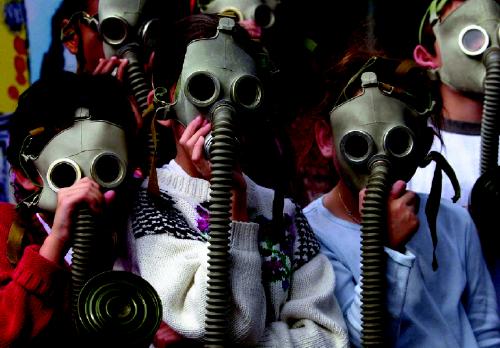Background and epidemiology: Most North American school buses and transport trucks are powered by dieselfuelled engines. Diesel has become the fuel of choice because it is considered more economical. However, as evidence grows about the connection between diesel exhaust, air pollution and ill health, so does public pressure to use cleaner fuels and vehicles.
Diesel fuel produces exhaust components that tend to form into spherical, respirable particles about 0.1–0.5 μm in diameter. These particles consist of an inert carbonaceous core with a large surface area that is ideal for adsorbing heavy metals and organic compounds such as polycyclic aromatic hydrocarbons, which are small compounds of 3 to 5 benzene rings that diffuse easily through cell membranes and bind to receptors within the cytoplasm.1
In 1989 the International Agency for Research on Cancer identified exhaust emissions from diesel engines as a probable human carcinogen.2 A number of studies have linked occupational exposure to diesel engine emissions with an elevated risk of lung cancer.3,4 In addition, diesel exhaust contains several of the Environmental Protection Agency's “criteria” air pollutants (www.epa.gov/air/urbanair/6poll.html) — including sulfur dioxide and fine particulate matter (< 10 μ in diameter) — that have been associated with the exacerbation of asthma. Once inhaled, diesel-exhaust particles are thought to promote the release of specific cytokines, immunoglobulins and oxidants, which can culminate in airway inflammation, mucous secretion, serum leakage into the airways and contraction of bronchial smooth muscle.1
The link between exposure to diesel exhaust and asthma has been borne out epidemiologically in studies indicating that children living along major trucking thoroughfares are at increased risk of asthma and allergic symptoms5 and of having objective evidence of respiratory dysfunction.6 Last year the National Resources Defense Council conducted a study to measure the level of diesel exhaust to which children are typically exposed as they ride on buses to and from school.2 The study showed that a child riding inside a diesel school bus may be exposed to as much as 4 times the level of diesel exhaust as someone riding in a car ahead of it. Exposure levels were higher in the back of the bus and when windows were closed. The study indicated that exposure of children to diesel exhaust while riding in a school bus for 1–2 hours a day, 180 days a year for 10 years might result in 23–46 additional cancer deaths per 1 million children. In addition, the investigators stated that the implications of this exposure for asthma are very troubling.2
Clinical management: Physicians can refer to the clinical asthma consensus guidelines for general principles in the management of asthma (www.cmaj.ca/cgi/content/full/161/11_suppl_1/s1). Although exposure to diesel-exhaust particles is not mentioned specifically, a smog advisory has been developed for parents, counselling them about activity levels, air conditioners and the importance of monitoring respiratory function during bad air days (www.oma.org/phealth/smogwisekids.htm).
Prevention: There are numerous strategies for reducing diesel exhaust, from enacting anti-idling policies to switching to cleaner diesel fuel, such as soya-based biodiesel. Federal legislation to reduce the sulfur content of on-road diesel to 15 ppm (from the current 500 ppm) is set to become law this summer. This legislation, coupled with new engine and emission technologies, will reduce emissions from on-road vehicles by 90%–95%.7 Older diesel buses can be retrofitted with particulate traps, which require the use of low-sulfur diesel fuel to be effective.2
Cleaner, alternative-fuelled buses often use compressed or liquefied natural gas, comprised primarily of methane. Studies suggest that the initial investment costs of purchasing the buses and establishing refuelling stations can be recouped over time because the cleaner burning fuel means fewer oil changes and less overall maintenance.2 The clean alternatives of tomorrow include hybrid-electric, battery-electric and fuel-cell buses. Although the technology for these alternatives is still very young, demonstration and pilot projects are currently operating in several countries (www.calstart.org/programs/p-santab.html), and they are being watched with interest by several more.
Erica Weir CMAJ

Figure. One answer to diesel fumes? Photo by: Canapress
References
- 1.Pandya R, Solomon G, Kinner A, Balmes J. Diesel exhaust and asthma: hypotheses and molecular mechanisms of action. Environ Health Perspect 2002;110(Suppl 1):103-12. [DOI] [PMC free article] [PubMed]
- 2.National Resources Defense Council Coalition for Clean Air. No breathing in the aisles — diesel exhaust inside school buses. New York: The Council; January 2001. Available: www.nrdc.org/air/transportation/schoolbus/sbusinx.asp (accessed 2002 July 16).
- 3.Garshick E, Schenker MB, Munoz A, Segal M, Smith T, Woskie S, et al. A retrospective cohort study of lung cancer and diesel exhaust exposure in railroad workers. Am Rev Respir Dis 1988;137 (4):820-5. [DOI] [PubMed]
- 4.Bofetta P, Dosemeci M, Gridley G, Bath H, Moradi T, Silverman D. Occupational exposure to diesel engine emissions and risk of cancer in Swedish men and women. Cancer Causes Control 2001;12:365-74. [DOI] [PubMed]
- 5.Northbridge M, Yankura J, Kinney P, Santella R, Shepard P, Riojas Y, et al. Diesel exhaust exposure among adolescents in Harlem: a community-driven study. Am J Public Health 1999;89:998-1002. [DOI] [PMC free article] [PubMed]
- 6.Brunekreef B, Jansses N, de Hartog J, Harssema H, Knape M, van Vliet P. Air pollution from truck traffic and lung function in children living near motorways. Epidemiology 1997;8(3):298-303. [DOI] [PubMed]
- 7.Sulphur in diesel fuel regulations. Canada GazettePart I 2001;Dec 22:4855-8. Available (pdf format): www .ec.gc.ca/ceparegistry/regulations/g1-13551 _r1 .pdf (accessed 2002 July 18).


